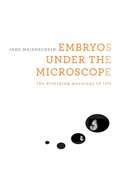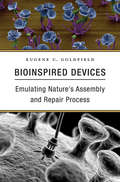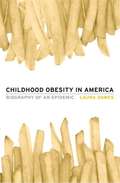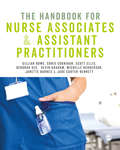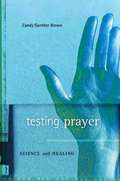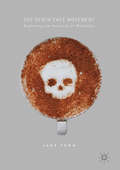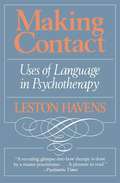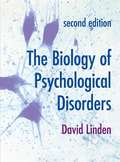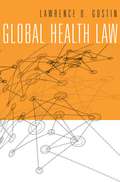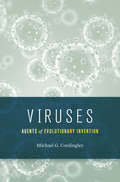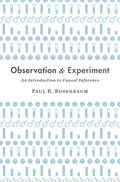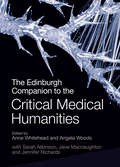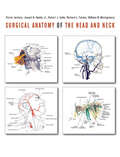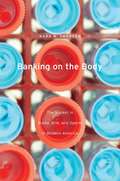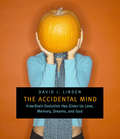- Table View
- List View
Banking on the Body: The Market In Blood, Milk, And Sperm In Modern America
by Kara W. SwansonEach year Americans supply blood, sperm, and breast milk to "banks" that store these products for use by strangers in medical procedures. Who gives, who receives, who profits? Kara Swanson traces body banks from the first experiments that discovered therapeutic uses for body products to current websites that facilitate a thriving global exchange.
Eugene Braunwald and the Rise of Modern Medicine
by Thomas H. LeeMuch of the improved survival rate from heart attack can be traced to Eugene Braunwald's work. He proved that myocardial infarction was an hours-long dynamic process which could be altered by treatment. Thomas H. Lee tells the life story of a physician whose activist approach transformed not just cardiology but the culture of American medicine.
Embryos under the Microscope: The Diverging Meanings Of Life
by Jane MaienscheinJane Maienschein examines how understanding of embryos evolved from the speculations of natural philosophers to bioengineering, with its life-enhancing therapies. She shows that research on embryos has always seemed promising to some but frightening to others, and makes the case that public understanding must be informed by scientific findings.
Obstetrics and Gynecology in Low-Resource Settings: A Practical Guide
by Nawal M. NourObstetrics and Gynecology in Low-Resource Settings provides practical guidelines for ensuring quality care to women in locations where facilities are inadequate, equipment and medications are in short supply, and medical staff are few. This reference will be an essential companion to health care providers throughout the world.
Bioinspired Devices: Emulating Nature’s Assembly and Repair Process
by Eugene C. GoldfieldEugene Goldfield lays out principles of engineering found in the natural world, with a focus on how components of coordinated structures organize themselves into autonomous functional systems. This self-organizing capacity is one of many qualities which can be harnessed to design technologies that can interact seamlessly with human bodies.
Childhood Obesity in America: Biography Of An Epidemic
by Laura DawesObesity among American children has reached epidemic proportions. Laura Dawes traces changes in diagnosis, treatment, and popular conceptions of the most serious health problem facing American children today, and makes the case that understanding the cultural history of a disease is critical to developing effective public health policy.
Social Neuroscience: Brain, Mind, And Society
by Russell K. SchuttHuman beings evolved in the company of others. Mutually reinforcing connections between brains, minds, and societies have profound implications for physical and emotional health. Social Neuroscience offers a comprehensive new framework for studying human brain development and human behavior in their social context.
The Handbook for Nurse Associates and Assistant Practitioners
by Kevin Graham Gillian Rowe Chris Counihan Scott Ellis Deborah Gee Michelle Henderson Janette Barnes Jade Carter-BennettWritten specifically for students who are undertaking a foundation degree or higher level apprenticeship in healthcare practice, or for those studying for the new nurse associate role, this book provides readers with the core knowledge and skills, giving them a springboard to further study. Key features include: a one-stop shop for the course including a broad range of topics such as study skills, professional development, infection control and health promotion, health sciences, mental health, learning disabilities, children and families, clinical case studies throughout to show how theory relates to real-life practice different levels of activity to help students ‘step up learning’ whether they are at level 4 or 5 Written by a wide range of authors with both experience in practice and in running degrees in nursing and health, the book is essential reading for all healthcare support workers, assistant practitioners and nurse associates.
The Handbook for Nurse Associates and Assistant Practitioners
by Kevin Graham Gillian Rowe Chris Counihan Scott Ellis Deborah Gee Michelle Henderson Janette Barnes Jade Carter-BennettWritten specifically for students who are undertaking a foundation degree or higher level apprenticeship in healthcare practice, or for those studying for the new nurse associate role, this book provides readers with the core knowledge and skills, giving them a springboard to further study. Key features include: a one-stop shop for the course including a broad range of topics such as study skills, professional development, infection control and health promotion, health sciences, mental health, learning disabilities, children and families, clinical case studies throughout to show how theory relates to real-life practice different levels of activity to help students ‘step up learning’ whether they are at level 4 or 5 Written by a wide range of authors with both experience in practice and in running degrees in nursing and health, the book is essential reading for all healthcare support workers, assistant practitioners and nurse associates.
Testing Prayer: Science And Healing
by Candy Gunther BrownDrawing on medical records, surveys of prayer recipients, prospective clinical trials, and multiyear follow-up observations and interviews, Brown shows that the widespread perception of prayer’s healing power has demonstrable social effects which can in some cases produce improvements in health that can be scientifically verified.
The Death Café Movement: Exploring the Horizons of Mortality
by Jack FongThis sociological work examines the phenomenon of the Death Café, a regular gathering of strangers from all walks of life who engage in “death talk” over coffee, tea, and desserts. Using insightful theoretical frameworks, Fong explores the common themes that constitute a “death identity” and reveals how Café attendees are inspired to live in light of death because of death. Fong examines how the participants’ embrace of self-sovereignty and confrontation of mortality revive their awareness of and appreciation for shared humanity. While divisive identity politics continue to foster neo-tribalisms and the construction of myriad “others,” Fong makes visible how those who participate in Death Cafés end up building community while being inspired toward living more fulfilling lives. Through death talk unfettered from systemic control, they end up feeling more agency over their own lived lives as well as being more conscious of the possibility of a good death. According to Fong, participants in this phenomenon offer us a sublime way to confront the facticity of our own demise—by gathering as one.
The Death Café Movement: Exploring the Horizons of Mortality
by Jack FongThis sociological work examines the phenomenon of the Death Café, a regular gathering of strangers from all walks of life who engage in “death talk” over coffee, tea, and desserts. Using insightful theoretical frameworks, Fong explores the common themes that constitute a “death identity” and reveals how Café attendees are inspired to live in light of death because of death. Fong examines how the participants’ embrace of self-sovereignty and confrontation of mortality revive their awareness of and appreciation for shared humanity. While divisive identity politics continue to foster neo-tribalisms and the construction of myriad “others,” Fong makes visible how those who participate in Death Cafés end up building community while being inspired toward living more fulfilling lives. Through death talk unfettered from systemic control, they end up feeling more agency over their own lived lives as well as being more conscious of the possibility of a good death. According to Fong, participants in this phenomenon offer us a sublime way to confront the facticity of our own demise—by gathering as one.
As the World Ages: Rethinking a Demographic Crisis
by Kavita Sivaramakrishnan SivaramakrishnanPeople are living longer, creating an unexpected boom in the elderly population. Longevity is increasing not only in wealthy countries but in developing nations as well. In response, many policy makers and scholars are preparing for a global crisis of aging. But for too long, Western experts have conceived of aging as a universal predicament—one that supposedly provokes the same welfare concerns in every context. In the twenty-first century, Kavita Sivaramakrishnan writes, we must embrace a new approach to the problem, one that prioritizes local agendas and values. As the World Ages is a history of how gerontologists, doctors, social scientists, and activists came to define the issue of global aging. Sivaramakrishnan shows that transnational organizations like the United Nations, private NGOs, and philanthropic foundations embraced programs that reflected prevailing Western ideas about development and modernization. The dominant paradigm often assumed that, because large-scale growth of an aging population happened first in the West, developing societies will experience the issues of aging in the same ways and on the same terms as their Western counterparts. But regional experts are beginning to question this one-size-fits-all model and have chosen instead to recast Western expertise in response to provincial conditions. Focusing on South Asia and Africa, Sivaramakrishnan shows how regional voices have argued for an approach that responds to local needs and concerns. The research presented in As the World Ages will help scholars, policy makers, and advocates appreciate the challenges of this recent shift in global demographics and find solutions sensitive to real life in diverse communities.
Making Contact: Uses Of Language In Psychotherapy
by Leston HavensSince 1955, moving from early work in psychopharmacology to studies of clinical method and the psychiatric schools, Leston Havens has been working toward a general theory of therapy. It often seems that twentieth-century psychiatry, sect-ridden, is a Tower of Babel, as Havens once characterized it. This book is the distillation of long years of thought and practice, a bold yet modest attempt to delineate an “integrated psychotherapy.” The boldness of this effort lies in its author’s willingness to recognize the best that each school has to offer, to describe it cogently, and to integrate it into a full response to today’s new kind of patient. Descriptive or medical psychiatry, psychoanalysis, interpersonal or behavioristic psychiatry, empathic or existential therapy-viewed in metaphors, respectively, of perceiving, thinking, managing, feeling-all have useful contributions to make to contemporary methods of treatment. But how? Havens’s modest answer is through appropriate language, and he demonstrates exactly what he means: when to ask questions, when to direct or draw back, when to sympathize. Practitioners now must deal with less dramatic, but more stubborn, problems of character and situation; lack of purpose, isolation, submissiveness, invasiveness, deep yet vague dissatisfaction. Some kind of human presence must be discovered in the patient, and Havens gives concrete, absorbing examples of ways of “speaking to absence,” of making contact. The emphasis is on verbal technique, but the underlying broad, humane intent is everywhere evident. It is no less than to transform passivity, by means of disciplined therapeutic concern, into a state of being Human.
Why Torture Doesn't Work: The Neuroscience of Interrogation
by Shane O'MaraBesides being cruel and inhumane, torture does not work the way torturers assume it does. As Shane O’Mara’s account of the neuroscience of suffering reveals, extreme stress creates profound problems for memory, mood, and thinking, and sufferers predictably produce information that is deeply unreliable, or even counterproductive and dangerous.
The Biology Of Psychological Disorders (PDF)
by David LindenPsychological disorders – their origins, clinical symptoms and treatment – have a central place in contemporary public health debate. Understanding how disruptions in the brain's biological mechanisms can influence our thoughts, feelings and actions is one of the most exciting challenges for psychologists in the twenty-first century. The Biology of Psychological Disorders is an authoritative account of some of the most prevalent psychological disorders, from schizophrenia, depression, mania and substance abuse to disorders of childhood, adolescence and ageing. Detailed and engaging coverage of these disorders is combined with a comprehensive grounding in the fundamentals of neuroscience and the principles of psychopharmacology that underpin their treatment. Drawing on the fields of psychology, psychiatry, neuroscience and biology, this highly relevant text is an invaluable resource for students of biological psychology and psychopharmacology, trainee psychiatrists and anyone interested in understanding, researching and treating psychological disorders.
Global Health Law: Biological Weapons, Public Health, And The Rule Of Law
by Lawrence O. GostinDespite global progress, staggering health inequalities between rich and poor raise basic questions of social justice. Defining the field of global health law, Lawrence Gostin drives home the need for effective governance and offers a blueprint for reform, based on the principle that the opportunity to live a healthy life is a basic human right.
Global Health Law
by Lawrence O. GostinDespite global progress, staggering health inequalities between rich and poor raise basic questions of social justice. Defining the field of global health law, Lawrence Gostin drives home the need for effective governance and offers a blueprint for reform, based on the principle that the opportunity to live a healthy life is a basic human right.
Viruses: Agents of Evolutionary Invention
by Michael G. CordingleyWhile viruses—the world’s most abundant biological entities—are not technically alive, they invade, replicate, and evolve within living cells. Michael Cordingley goes beyond our familiarity with infections to show how viruses spur evolutionary change in their hosts and shape global ecosystems, from ocean photosynthesis to drug-resistant bacteria.
Observation and Experiment: An Introduction to Causal Inference
by Paul R. RosenbaumIn the face of conflicting claims about some treatments, behaviors, and policies, the question arises: What is the most scientifically rigorous way to draw conclusions about cause and effect in the study of humans? In this introduction to causal inference, Paul Rosenbaum explains key concepts and methods through real-world examples.
The Edinburgh Companion to the Critical Medical Humanities (Edinburgh Companions To Literature )
by Anne Whitehead Angela Woods Sarah Atkinson Jane Macnaughton Jennifer RichardsIn this landmark Companion, expert contributors from around the world map out the field of the critical medical humanities. This is the first volume to comprehensively introduce the ways in which interdisciplinary thinking across the humanities and social sciences might contribute to, critique and develop medical understanding of the human individually and collectively. The thirty-six newly commissioned chapters range widely within and across disciplinary fields, always alert to the intersections between medicine, as broadly defined, and critical thinking. Each chapter offers suggestions for further reading on the issues raised, and each section concludes with an Afterword, written by a leading critic, outlining future possibilities for cutting-edge work in this area.
The Edinburgh Companion To The Critical Medical Humanities (Edinburgh Companions To Literature )
by Anne Whitehead Angela Woods Sarah Atkinson Jane Macnaughton Jennifer RichardsIn this landmark Companion, expert contributors from around the world map out the field of the critical medical humanities. This is the first volume to comprehensively introduce the ways in which interdisciplinary thinking across the humanities and social sciences might contribute to, critique and develop medical understanding of the human individually and collectively. The thirty-six newly commissioned chapters range widely within and across disciplinary fields, always alert to the intersections between medicine, as broadly defined, and critical thinking. Each chapter offers suggestions for further reading on the issues raised, and each section concludes with an Afterword, written by a leading critic, outlining future possibilities for cutting-edge work in this area.
Surgical Anatomy of the Head and Neck
by Parviz JanfazaSurgical Anatomy of the Head and Neck was hailed as indispensable when it was first published in 2001. This classic atlas—packed with over 700 exceptional drawings, 537 of them in full color—is now available again after years of being out of print. An invaluable reference for surgeons, residents, and medical students.
Banking on the Body: The Market In Blood, Milk, And Sperm In Modern America
by Kara W. SwansonEach year Americans supply blood, sperm, and breast milk to "banks" that store these products for use by strangers in medical procedures. Who gives, who receives, who profits? Kara Swanson traces body banks from the first experiments that discovered therapeutic uses for body products to current websites that facilitate a thriving global exchange.
The Accidental Mind: How Brain Evolution Has Given Us Love, Memory, Dreams, And God
by David J. LindenLinden sets the record straight about the construction of the human brain; rather than the “beautifully-engineered optimized device, the absolute pinnacle of design” portrayed in many dumbed-down text books, pop-science tomes, and education televisions programs, Linden’s organ is a complicated assembly of cobbled-together functionality that created the mind as a by-product of ad-hoc solutions to questions of survival. His guided tour of the glorious amalgam of “crummy parts” includes pit-stops in the histories and fundamentals of neurology, neural-psychology, physiology, molecular and cellular biology, and genetics.

